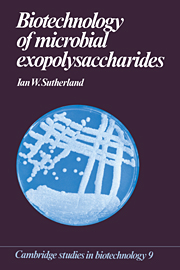Book contents
- Frontmatter
- Contents
- Preface
- 1 Introduction and definition
- 2 Polysaccharide analysis and structural determination
- 3 Exopolysaccharide structure
- 4 Enzymes degrading exopolysaccharides
- 5 Biosynthesis
- 6 Physiology and industrial production
- 7 Genetics, control and regulation of exopolysaccharide synthesis
- 8 Physical properties of exopolysaccharides
- 9 Food usage of exopolysaccharides
- 10 Industrial uses of microbial polysaccharides
- 11 Medical applications of exopolysaccharides
- 12 The future for microbial exopolysaccharides
- References
- Index
1 - Introduction and definition
Published online by Cambridge University Press: 09 September 2009
- Frontmatter
- Contents
- Preface
- 1 Introduction and definition
- 2 Polysaccharide analysis and structural determination
- 3 Exopolysaccharide structure
- 4 Enzymes degrading exopolysaccharides
- 5 Biosynthesis
- 6 Physiology and industrial production
- 7 Genetics, control and regulation of exopolysaccharide synthesis
- 8 Physical properties of exopolysaccharides
- 9 Food usage of exopolysaccharides
- 10 Industrial uses of microbial polysaccharides
- 11 Medical applications of exopolysaccharides
- 12 The future for microbial exopolysaccharides
- References
- Index
Summary
Introduction
The surface of the microbial cell is a rich source of carbohydrate-containing molecules. Some of these are unique types, confined to a limited range of microorganisms. These are the components of the microbial cell walls such as yeast mannans, bacterial teichoic and teichuronic acids, lipopolysaccharides and peptidoglycan. However, in addition to these wall components, polysaccharides may be found either associated with other surface macromolecules or totally dissociated from the microbial cell. These are exopolysaccharides, extracellular polysaccharides showing considerable diversity in their composition and structure. Some of these polymers may bear a strong chemical similarity to cell-wall components, but the majority are distinct chemical structures totally unrelated to cellular constituents.
Exopolysaccharides occur widely, especially among prokaryotic species, both among those that are free-living saprophytes and among those that are pathogenic to humans, animals and plants. Most microalgae yield some type of exopolysaccharide but they are less common among yeasts and fungi. However, some of those isolated from fungi do possess interesting physical and pharmacological properties.
Definition of exopolysaccharides is more difficult than definition of the carbohydrate-containing polymers found in microbial walls. The term exopolysaccharide has been widely used to describe polysaccharides found external to the structural outer surface of the microbial cell and it can be applied to polymers of very diverse composition and of different physical types. The term glycocalyx, introduced by Costerton, fails to differentiate between the different chemical entities found at the microbial surface. It has been used to represent a complex array of macromolecular species inlcuding components which are truly extracellular, together with wall polysaccharides and many other non-carbohydrate-containing chemical species.
- Type
- Chapter
- Information
- Biotechnology of Microbial Exopolysaccharides , pp. 1 - 11Publisher: Cambridge University PressPrint publication year: 1990
- 1
- Cited by



